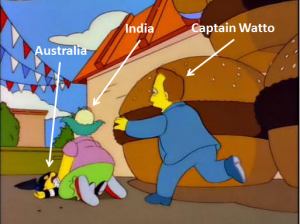
A gradual but inevitable descent into cricket-based loathing and bile.
India vs. Australia: Series Roundup
While the India vs. Australia series has been a lot of fun (we’re talking about the Super Mario Kart end of the enjoyment scale here), there’s a feeling that perhaps we’ve focused too much on the pleasure aspect – Australia getting utterly spanked – rather than talking about the real issues of the series. And when we say a feeling, we mean a nasty note written in green ink and left on the fridge by Editor Steve, shortly before his latest jaunt around Europe to lambaste a terrible international football side. Hence we find ourselves having to actually try and write a grownup piece, rather than just dressing up player ratings with a series of pictures of low quality international footballers/drink drivers.
But what were the most important issues behind one of the most entertaining series we’ve ever laughed (and drunk) our way through? Well, let’s start with this one:
The result pitch is king
It’s easy to argue about whether the pitches for this series were ‘good’ or ‘bad’. They certainly didn’t look all that appealing, starting off looking like a day five pitch and crumbling like the former Mrs Nichael Bluth’s shoddy baking. But from our point of view, these pitches are infinitely better than the roads produced in New Zealand to guarantee five days of ‘action’. Test Cricket needs results. These pitches produce results. What more could you ask for?
Of course, there are a few questions about home advantage being taken to this ridiculous extreme, but there’s not much wrong with that – these are the problems that an away side just has to overcome. England found a way; Australia very clearly didn’t.
Continuity is, er, also king
Among Australia’s many problems was a complete lack of continuity. From top to bottom, everything seemed to be made up as they went along. While this approach can work for podcasting or for all-star musical ensembles, it really doesn’t work for building a Test side. In particular, the handling of Nathan Lyon made absolutely no sense. Having essentially gambled on him learning his craft at the top level, to drop him after one poor game was madness, especially given that the reserve spinners weren’t exactly beating down the door. Indeed, Xavier Doherty’s performance at Test level are those of a man deliberately building a whole new level of reinforced door, with him on the wrong side of it.

Torturous metaphor complete, X-Doh settled down to a pleasant night in the cells, well away from MS Dhoni’s batting.
After X-Doh and Glenn Maxwell failed to bowl anything other than utter filth, Lyon returned to the side to take his Test best figures in Delhi. Mickey Arthur and friends may suggest that this was due to them dealing with his ‘technical issues’, which couldn’t be a bigger load of bollocks – they’re paid to do these things between matches, not during them. Instead, Australia’s best spinner bowled well in helpful conditions, something he couldn’t exactly do from the sidelines.
Picking players in form: a good idea
It may have taken several years, but India finally seemed to have grasped the idea of not picking a side on reputation (with the obvious exception of Sachin Tendulkar). Sehwag and Gambhir have been coasting along for as long as we can remember, seemingly immune from the axe. Now suddenly both of them are considering life in the margins, wandering the streets of Delhi like marginally less shambolic versions of Noel Edmonds. From India’s perspective, this is a good thing. Harbhajan Singh should be next to find himself discarded, leaving only the question of Tendulkar left to resolve before the side can finally consider itself reborn. We’re genuinely excited to see how this side goes in South Africa.
Fudging the issue with allrounders: a bad idea
For as many years as we can possibly remember, England dicked around trying to find the new Ian Botham. This led to such luminaries as Craig White, Dermot Reeve and Mark Ealham playing Test cricket, with almost uniformly disappointing results. The points we’re trying to make here are (1) read some of our old articles – they’re great! – and (2) picking a substandard allrounder never works (see also Patel, Samit). Australia’s tactics for this series involved picking combinations of both Moises Henriques and Glenn Maxwell, a plan utterly destined for failure. In addition, in order to accomodate a combination of these two, Matt Wade was bumped up to bat at six, further highlighting his lack of ability with the bat.
The end result of all this was a real mess of a lower middle order, following on from a real mess of a top order. We should also point out that keeping up to the stumps is far more difficult than standing back – if ever a tour really demanded a genuine keeper it was this one. Unfortunately for Australia, Matt Wade isn’t a genuine keeper, instead being the more modern ‘batsman with big gloves on’.
Shane Watson is rubbish
He doesn’t bowl. He can’t bat. Australia have got themselves into a massive mess by fudging the Watson issue for several years. Time for him to score big runs outside of the Test side and actually earn his place once again, especially since Devereux completely showed him up by actually applying himself. Or alternatively, Australia could just make Watson captain, the utter, utter muppets.





No Comments
Post a Comment